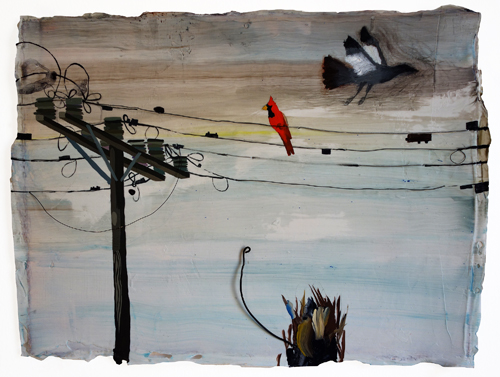“Abstraction talks her head off. She has a lot to say.”
You might not hear her right away, but Jennifer Wynne Reeves does. “I tune out or listen,” she adds, in the penciled text within a painting, “rattled by her noisy silence.” She is also silently talking back. She could be abstracting away from reality, building life on abstraction, or discovering her inner child.
Reeves sticks her text on three paintings, all from late 2012 and 2013, as if cut from a school notebook by a precocious learner. Each fragment shares a wooden frame with shards of acrylic or molding paste, but nothing within the frame, least of all abstraction. In due course, with Untitled Collage, one may spot loose grids of soft colors, as with Paul Klee, but with more shards sticking off the edges. They could pass for shattered porcelain from her morning coffee or the leavings of a brush wiped clean, on the way to painting something else. And mostly that something else is telling stories. Abstraction has the choice of tuning out or listening.
Maybe Reeves has not really saved her notebook all these years (and her texts often appear as Facebook posts as well, perhaps to rethink physical drawing as part of an ongoing virtual project). Still, a drawing from age nine does greet visitors on the way in—alongside a few messy sculptures somewhere between figurines, abstraction, and child’s play. She calls the show “The Worms in the Wall at Mondrian’s House,” as if Piet Mondrian had grown up on it. And the same gallery has had echoes of outsider art and personal confessions from Amy Wilson.
Yet Reeves is not as innocent as she may appear. Her gouache on paper has its realism, like the gray streaks of a damp sky or the scumbled vegetation of an open field. It also has somber dreams. The sailboat in Grace Note passes beneath a rainbow all but landing on its deck, and her characters are often at sea. A traveler in Far Away but Not Far Apart crosses a bridge in low light, behind fencing not at all comforting in its whiteness. A prancing horse in Horse Comforter does not escape its tether, and a wolf howls at a star. In I See Two Birds a shotgun brings down a bird, although another bird flies above, while a robin perches comfortably on a power line.
Actual wire, for her, is part of abstraction’s sign language. She draws with it and puns on it, as with the tense coils of those utility poles. Maybe she exaggerates the coiling and its looseness, but electricity works that way, and so does the loneliness of power lines beside a road.
When it comes to abstraction, many artists today feel a certain ambivalence. Like Amy Sillman, Sara VanDerBeek, and so many others, they are looking for a space between abstraction and realism. In the end, Reeves and abstraction reach an accommodation—”a perfectly unexpected Boogie Woogie.” Still, these are first and foremost her own stories, far from Mondrian’s Broadway.


